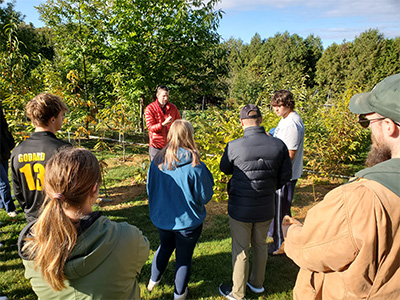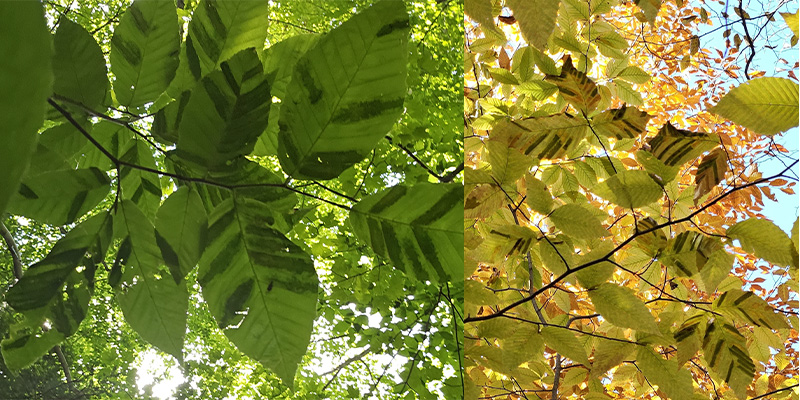SUNY ESF
Progress Report 2024
The past year has been full of challenges and important progress for ESF’s American Chestnut Research and Restoration Project. As most of you know, project co-founders Dr. William Powell and Dr. Charles Maynard passed away in November 2023 and February 2024, respectively. We miss them deeply and strive to honor their legacy by continuing the important work they began. We also learned of a labeling error (trees we had been calling Darling 58 were actually Darling 54) and faced a series of criticisms, many of which were exaggerated or misleading. Despite the challenges, our team remained positive and united. We have spent much of 2024 working to better understand Darling and DarWin trees, correct the labeling mistake, improve existing lines, and develop new ones. This update includes summaries of several research projects, the regulatory review process, and new work on chestnut and other threatened trees. We are working on ways to share brief updates more regularly throughout the year, so stay tuned!
Thank you for your continued interest in and support of our project. We’ve appreciated hearing from many of you over the past year, and a majority of our research funding continues to come from philanthropic foundations and donors like you, so we couldn’t keep going without you! Please visit Chestnut website to contact us, make a donation, or follow future updates.
Sincerely,
Andy Newhouse and the ESF American Chestnut Research and Restoration Project team
Partnerships and outreach
We are pleased to announce new and continued support from several partners, notably including the New York Chapter of The American Chestnut Foundation and the New York State Department of Environmental Conservation. In conjunction with other educational and research partnerships, these collaborations will help us work toward restoration of American chestnuts and other threatened native trees. Production and distribution of blight-tolerant trees for restoration is a much bigger task than any one group could attempt alone, so ESF has developed a non-exclusive license structure. This will facilitate distribution at different scales by leveraging the strengths of various groups who share our conservation goals, while helping to fund ongoing research.

Photo: Project Director Andrew Newhouse shares chestnut project updates with a local school group.
Tree production in 2024
ESF had a productive harvest this year! We hand-pollinated over 10,000 flowers with transgenic pollen on 115 mother trees from diverse genetic backgrounds (American, hybrid, Allegheny and Ozark chinquapins), resulting in more than 11,000 seeds. Approximately 700 of these seeds originated from the first selective breeding with pollen from elite Darling 54 trees in the field, showing the best height, growth form, and blight tolerance so far. We are excited to plant and study these offspring, which we expect will grow into some of the most promising Darling trees yet. In another major milestone, we produced pollen from healthy homozygous trees (those with two copies of OxO from two Darling parents), which yielded ~300 seeds. Initial results confirm that more than 99% of these offspring inherited OxO, exactly as expected. Pollen from homozygous trees will be an important tool to maximize production of transgenic chestnuts and help conserve rare or valuable trees.
Transgene expression in five generations of Darling 54 offspring
One important consideration for the use of transgenic trees in environmental conservation is the stability of transgene expression across multiple generations. Some transgenic crop plants have shown transgene silencing or decreased expression in offspring generations, so we have checked very carefully for this phenomenon in Darling chestnuts. This year we studied transgene expression in three Darling 54 families, spanning five offspring generations. There was fluctuation in expression values as expected from different environmental conditions and family backgrounds, but no indication of transgene silencing over five generations. Most tested offspring had higher expression than the progenitor. This suggests that the OxO transgene will continue to impart blight tolerance as it is passed to offspring. A full manuscript describing this study is currently being prepared for publication.
Darling 54 growth rates and blight tolerance
Measurements of chestnut growth rates in well-replicated plots have shown significant differences among chestnut varieties. Average growth rates of transgenic trees in one key multi-state experiment (called BRAG, for Biotechnology Risk Assessment Grant) are slower compared to non-transgenic seedlings but are similar to other varieties, such as backcross hybrid chestnuts. We have seen similar results in other plots where transgenic trees, on average, grow slower than their non-transgenic relatives, which may be a trade-off for enhanced blight tolerance. Response to blight in Darling trees is variable: some trees die back, others show no symptoms, while a majority develop several non-lethal cankers and keep growing. In contrast, related non-transgenic seedlings are susceptible and generally die back. This makes it difficult to compare height growth over time, as blight-susceptible control trees die back while transgenic trees generally survive, but it is clear that Darling trees have better blight tolerance than any other American chestnut we have studied. We continue to investigate offspring of genetically diverse Darling 54 families, selecting the best performing trees for blight tolerance and growth, to eventually use for selective breeding.

Photo: Vigorous transgenic American chestnut seedlings growing with related controls in a greenhouse
Regulatory update
We expected the regulatory review process for Darling trees to be slow, especially given the unprecedented nature of this use of biotechnology for environmental conservation. Unfortunately, we were right about that! However, the agencies have not identified risks or safety concerns, and the name correction (Darling 58 to Darling 54) does not change those conclusions. The process was delayed temporarily until we submitted a fully corrected and updated Petition to the USDA this summer, which should be available for public review soon. As with previous public comment periods, we’d appreciate any supportive comments for the revised Darling 54 petition!
Next steps for American chestnut
While we continue to study and improve Darling and DarWin trees, we are also studying new promoters and candidate blight-resistance genes to develop new lines of blight-tolerant American chestnut. DarWin chestnuts ramp up expression of OxO specifically in response to wounding and blight infection. Examples of transformations in our pipeline include OxO driven by a citrus phloem promoter, which should express the transgene in the phloem, one of the first tissues disrupted by the fungus; a germin-like protein gene from chestnut, which is in the same family of genes as OxO; and a laccase gene from Chinese chestnut, which may help strengthen cell walls and reduce the spread of the blight fungus in the tree. These new genes will be tested alone and in combination with OxO to optimize blight resistance. We are also testing two RNA interference (RNAi) vectors that could inhibit specific genes in the blight fungus. RNAi is a natural component of plant immune systems and has effectively enhanced disease resistance in other plants, so it may complement other blight-tolerance traits in American chestnuts.
Addressing other threatened species
It has been three years since we started a backcross breeding program to introduce the OxO gene from transgenic American chestnuts to Ozark chinquapins. We crossed Ozark chinquapins with Darling American chestnut pollen and studied the hybrid progeny. We confirmed that the OxO gene is inherited and expressed in these plants, and we planted dozens of transgenic and non-transgenic hybrids in the research field. Inoculations of young plants suggest that OxO, like in American chestnut, increases blight tolerance of these hybrids. We are going in the right direction! Next we will start “diluting” the American chestnut characteristics through breeding to obtain a plant that is mostly Ozark chinquapin. This summer, we moved one step closer to our goal: we crossed Ozark chinquapin mother trees with transgenic hybrid pollen. This next generation is expected to be 75% Ozark and 25% American, and we are very excited to continue studying these trees
We are also applying tools we’ve developed for chestnut toward more distantly related trees. We have been working on American elm for several years, and we are now conducting preliminary tests on transgenic elm trees that may resist the insects that spread Dutch elm disease and Elm yellows. American beech is in the same family as American chestnut, and it has recently come under threat from a pest causing Beech Leaf Disease (BLD). The New York DEC has provided funding to our lab to expand research in this area. Scientists are just starting to understand how BLD spreads and affects trees, so it is too early to start developing transgenic beech trees. However, our research team is studying microbes found in some beech leaves that could lead to biocontrol treatments, and adapting chestnut tissue culture protocols to help conserve and propagate valuable beech trees. Would it not be poetic if American chestnut technology helped other threatened species?

Photo: American beech leaves with Beech Leaf Disease (indicated by dark bands between veins). Learn more or report BLD infections to the DEC Beech Leaf Disease
